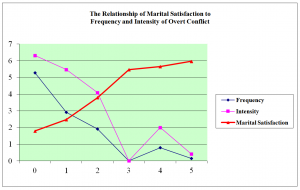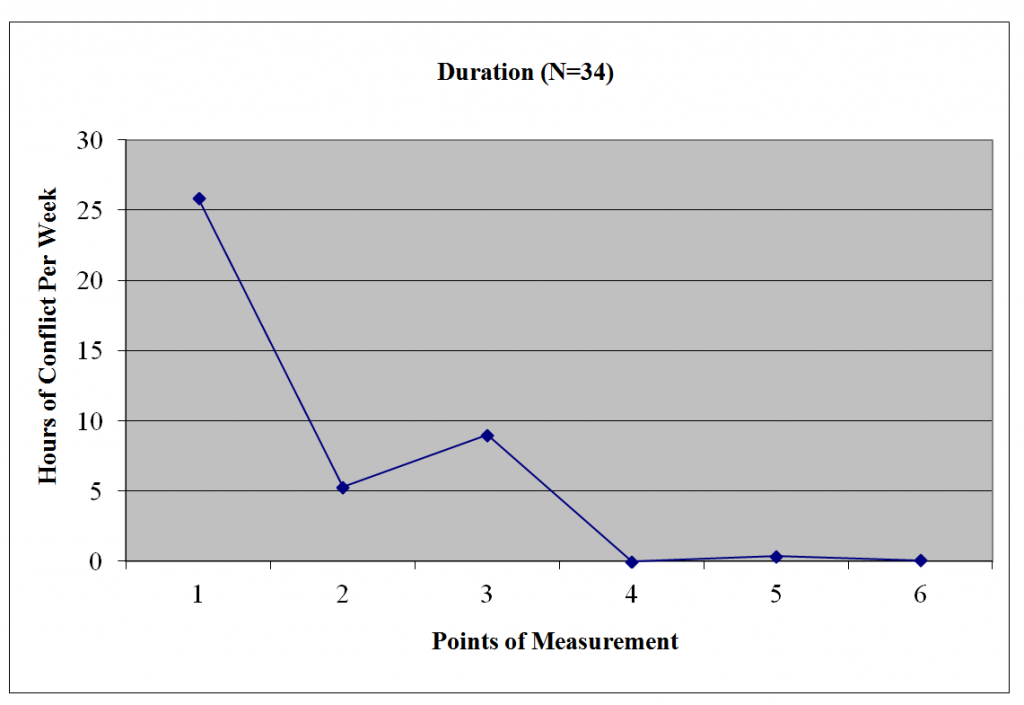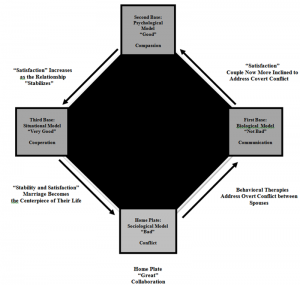Dr. Gary “Buddy” Burge: “The Marriage Therapist”
“Heal your Marriage in Four to Six Weeks with One of Canada’s Leading Marriage Therapists”
Experience
For 60 years Dr. Gary “Buddy” Burge has been one of Canada’s leading experts on marital satisfaction and North America’s foremost authority on the “Executive” Marriage.
Specialized Marital Research and Training
In his doctoral dissertation on “Resolving Marital Conflict”, the marital satisfaction of participating couples improved from an average of 1.53 out of 7, (Extremely Dissatisfied) to an average of 5.97 out of 7, (Extremely Satisfied).
They were arguing five times a week, with an intensity level of 6.4/7.0, they were screaming at each other for an average of 26 hours a week.
They stopped arguing completely after only four sessions.
Therapeutic and Academic Qualifications
A vast and varied therapeutic and academic background, Gary was trained at York University, the University of Toronto, and the Alfred Adler Institute (Chicago).
He also holds a master’s degree from the Fuller School of Psychology in Pasadena, California and a Ph.D. in Social Sciences with Specialization in the Field of Organizational Psychology from the International Graduate School at Berne University.
Credentials
He holds 31 other professional designations designed to help him be as effective as possible helping couples restore and heal their broken marriages.
For 15 years, he worked at a clinic at the Etobicoke General Hospital in Toronto with over 120 physicians who would refer patients with troubled marriages to his care.
Since 1971, he has spent over 42,000 hours helping clients restore their broken marriages.
To this day, 93% of the couples who work with Dr. Burge decide to stay in their marriages, living more satisfied, fulfilled lives.
To this day, he still sees up to 40 couples a week in his practice and rarely do couples need more than 8 to 10 sessions to get the outcome they want, “a happy life by virtue of a happy marriage.”
Author: Twenty-Three Books on Marriage and Communication
Gary has written 23 books on marriage and business conflict/communication.
His doctoral dissertation and research on marital conflict and communication are the basis for his latest book, “How to Have a Great Marriage – The Art and Science of Marital Happiness”.
Gary specializes in and does only one kind of therapy – marital.
Further to that, he is the country’s leading authority on the “Executive” Marriage, the marriages of highly successful business leaders whose marriages face complexities and issues that many others of us do.
He is the Executive Director of the Kleinburg Counselling Institute and Founding President of the Step and Blended Family Institute of Canada.
Happily married for 52 years (August 7, 1971), Gary has worked with married couples since 1969 (55 years).
You can visit Dr. Burge at www.TheMarriageTherapist.ca
Scientific Evidence That You Will Get the Breakthrough You Need in Less Than Six Weeks
Research Data from my Ph.D. Dissertation
In my doctoral dissertation, after seven years of research at a major Toronto hospital, by the way, I measured the amount of arguing (overt conflict) couples did using three criteria.
The specific overt conflict components in the Overt Conflict (below) Scale to be measured were:
1. Conflict Frequency: The Number of Reported Marital Conflicts per Week
2. Conflict Duration: The Reported Length of Time to Resolve Marital Conflict
3. Conflict Intensity: The Reported Level of Negative Emotion during Conflict
Note, in the first chart below, these couples were arguing more than five times a week, with an intensity level of 6.4 out of seven. And in the second chart below, they were arguing on average, 26 hours per week These were indeed very troubled marriages.
But also note, these very same couples (who initially scored their marital satisfaction at 1.53 out of 7 on day one of therapy), after only five weeks, rated their marital happiness at 6 out of 7 (the ascending red line).
Yes, you heard right, 93% of the time these couples restored their marital happiness – from 1.53/7.00 to 6/7.00, in less than 5 weeks.
You can and should expect the very same results as we work together.
Reported Duration of Overt Conflict
The research group was measured for the duration of conflicts (length of conflict in hours) per week on six different occasions. Measurement Point One denotes the pre-training measurement.
The subsequent five measurement points were taken during the training process.
The fourth of the six training measurement points on the graph below indicates the point at which the couple experienced zero conflicts in a given week (First Base).
We Will Use the Four Therapies Science Has Declared Are
the Four Best Strategies We Could Possibly Use to Heal Your Marriage
For many years (the 1980’s to the early 2000s) I worked at a clinic at a major hospital in the west end of the city of Toronto that partnered with 120 physicians who referred patients to me with troubled marriages.
As stated elsewhere, 93% of these couples ended up happily married.
On average their marriages in 5 weeks improved from 1.73/7.00 to 6.00/7.00 in five weeks.
During that time there were four counseling strategies I was using to help these couples.
Then, for the research portion of my doctoral dissertation on marital conflict, I reviewed the 115 longitudinal marital studies for the period covering 1938 (the first longitudinal marital study) to 1995.
These 115 longitudinal studies reviewed and assessed over 45,000 marriages.
According to the Scientific Literature the Four
Most Potent Marriage Counselling Strategies
The results were quite stunning for me personally in that the four most potent therapies during that time, were the four therapies I was using in my practice and in the sequence with which I was applying them.
The four therapies were:
- Social Exchange Model – “Conflict”
- Behavioral Model – “Communication”
- Attachment Model – “Compassion”
- Crisis Model – “Cooperation”
These four therapies or stages then give rise to “Collaboration” (Home Plate).
The importance of this for those of you considering partnering with me to restore and heal your marriage is that rather than psycho-babble or psychological mumble jumble, we will use the four therapies science says are the very best strategies we could possibly use to make yours a stable, harmonious, and happy marriage.
How to Have a Great Marriage:
The Baseball Diamond Analogy
In the baseball diagram below, you can see how the process to having a great marriage is analogous to the four stages or bases of a baseball diamond. Each stage/base represents one of the four primary issues that afflict most marriages and the specific therapy needed to resolve that concern.
At the Home plate, in the “Things are bad” stage, the issue is “Conflict” which calls for and leverages a sociological therapeutic model (Social Exchange).
At First Base, in the “Things are not bad” stage, the issue is “Communication” which calls for and leverages an interactional therapeutic model (Behavior Theory).
At Second Base, the “Things are good” stage, the issue is “Compassion” which calls for and leverages a psychological therapeutic model (Attachment Theory).
At Third Base, in the “Things are very good” stage, the issue is “Cooperation” which calls for and leverages a stress reduction therapeutic model (Crisis Theory).
Home Plate: (Collaboration) all four previous steps converge to create a loving, stable marriage.
How to Have a Great Marriage
Four-Stage Baseball Diamond Model
Home Plate: The Social Exchange Model
The Social Exchange Model is the most cited therapeutic model in the scientific research on marriage.
It asserts that we treat others, the way we think they treat us, as a matter of course. Stated more colloquially, the primary way spouses evaluate their marriage is “do I have a good deal with you” or “you scratch my back, I scratch yours, yes, but you are not scratching where I am itchy, well you should be itchy where I am itchy, what is your blankety-blank problem anyway?”
In other words, nobody can be happy in a marriage, when they think they have a bad deal, not getting from their partner the same love and respect that they think thay are giving. End of story.
Our ultimate goal therefore will be to help both of you feel that you really aced it or have a great, lucky or happy deal in your marriage. That is, your partner treats you with understanding, dignity, acknowledgment, and love, which you need and deserve.
First Base: The Behavioral Model
The second predominant model for resolving conflict and developing marital satisfaction and stability is the Behavioral Model.
Unlike the Social Exchange Model, which focuses on our very individual perceptions as to how well our partner treats us directly determines marital satisfaction, the Behavioral Model suggests that knowing the behaviors and language needed by each partner during their interactions influences spouses’ judgments as to the quality of their marriage.
In other words, language determines the conversation, the conversation determines the relationship and the relationship determines the outcome. Each of us, based on our specific and unique biological predisposition (temperament) needs very specific language. To know and use your partner’s language will break the logjam between the two of you. This realization, more than anything else, will help you elevate the conversation (as opposed to the typical conflict that bedevils most marital conversations), advance the relationship and the feelings therein, and create a transcendent resolution, the best of what each of you thinks, but an outcome that is even better.
First base, in our model, “communication”, which usually occurs by week four, means you can now talk about anything without arguing. What a tremendous breakthrough this stage represents for an unhappy and conflicted couple.
Second Base: The Attachment Model
The Attachment Model asserts that an individual’s early experiences in close relationships shape the nature and development of subsequent relationships in adulthood.
According to the Attachment Model, marital success or failure will be affected by enduring aspects of each partner’s relationship history and family of origin.
Each spouse’s spiritual mission is to bring healing to their partner’s “brokenness” by undoing in your partner the hurt or anxiety that has shaped the narrative they have developed to make sense of their lives. When this happens, each spouse feels, “Oh my goodness your “compassion” for me, the way you make me feel so safe and respected and deeply loved means that we now have a “good” marriage.
In other words, First Base is “helping” whereas, Second base is “healing”.
Third Base: The Crisis Model
Note: Home Plate to Second Base is about Connection while Second Base to Home Plate is about Cooperation.
Home Plate to Second Base is about being a Couple while Second Base to Home Plate is about being a Team.
Home Plate to Second Base is about Feeling while Second Base to Home Plate is about Function.
The Crisis Model explains how stressful events can damage a marriage. Since the advent of Covid19, and the increased stress confronting couples “stuck” together at home in unbearable circumstances, this model – how to reduce domestic stress – has become an even more important part of the process. So at this stage, motivated by the tremendous gains you have made in the first three stages and the deep satisfaction you have achieved, you organize your lives such that marital and circumstantial stress is reduced or eliminated and your marriage truly becomes the centerpiece of your life.
Third Base means that now your marriage is “Very Good”. It is marked by a deep feeling of “Cooperation” – a deep, detailed, and impenetrable domestic system that makes you not only a happy and satisfied couple but a wonderful team in control of the stresses that sabotage most marriages.
Home Plate: A Happy Marriage
A Wonderful Couple (Feeling Great) and an Outstanding Team (Doing Great)
Finally, you make your way to “Home Plate” where your marriage is marked by “Collaboration” and you truly have a “Great” marriage.



